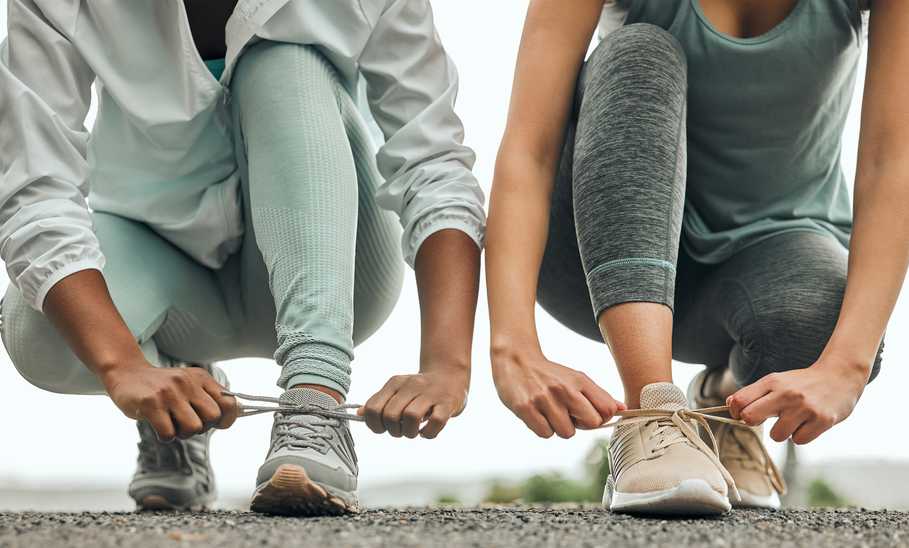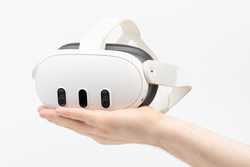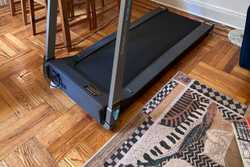Whether you’re training for a marathon or triathlon or just hitting the gym to keep your mind and body healthy, a quality pair of workout shoes is paramount. After all, you only get one pair of feet in your lifetime (future medical and scientific advancements notwithstanding). While you may be tempted to wear the same sneakers you keep by your front door for every activity, it's not always the best for the health of your feet.
“I constantly talk to the kids about taking care of their feet,” says Kristen Hislop, a track and cross-country coach at Hislop Coaching, “Many say their parents don't want to spend $150 on a pair of trainers, but it’s crazy important to wear the right footwear. So, yes, spend some money on them!” Jennifer Rulon, coach and author, recommends having multiple shoes for different workouts because shoe soles (as far as cushioning and support) vary greatly.
Our top picks for best workout shoes for women
Adidas Everyset Training Shoes
With a wide fit and minimal to medium cushioning, Adidas Everyset training shoes are a great budget friendly gym shoe. These are the kind of shoes you wear when lifting weights paired with a white t-shirt and sweatpants. They’ve got echoes of old school vibes with a price tag to match. If you’re not a fan of rocker soles and cloud-like cushioning, these are the shoes for you.
Specifications
- Widths: Medium
- Materials: Rubber, foam, knit; 50% recycled materials
- Weight: N/A
- Closure: Laces
- Cushioning level: Medium
- Drop: 6 mm
- Sizes: 5 - 19
- Colors: Black, white, gray
- Price on publish: $90
Pros:
- Wide toe box
- Old school style
- Budget friendly price
The bottom line:
Old school style workout shoes with a wide toe box and sole with medium cushioning—great for weight lifting.
Best workout shoes for women with flat feet: Naot Krypton

Naot Krypton
41% offSave $70
Featuring a 1.25 inch foam and rubber sole that absorbs shock, and a cork and latex footbed for arch support, Naot Kryptons offer a great choice for people with flat feet. The footbed has a deep heel indentation that keeps your natural foot position while protecting the heel bone (the cork style and construction is the kind you see often in sandals). They’re orthotic friendly for those with custom inserts. The Krypton features a durable sleek design and comes in three different color combinations.
Specifications
- Widths: Medium
- Materials: Rubber, foam
- Weight: 10 ounces
- Closure: Laces
- Cushioning level: Balanced
- Drop: Minimal (manufacturer doesn’t provide)
- Sizes: 4 - 11
- Colors: Black/gray, gray/light blue, dark blue/gray
- Price on publish: $169.95
Pros:
- Durable
- Removable cork and latex footbed
- Orthotic friendly
The bottom line:
Durable, lightweight, orthotic friendly gym shoe from Naot that works well for those with flat feet.
Best workout shoes for women with wide feet: Naot Adonis

Naot Adonis
Made with a soft, flexible breathable upper portion and a removable cork and latex footbed which molds to your foot with wear, the Naot Adonis offers a lightweight shoe with moderate cushioning for gym workouts. Made of 1.25 inch rubber and foam, the sole is extremely durable, so you’ll be able to wear it for a long time. The slip on style comes in four fetching color combinations including white and pink and black and gray.
“Overall, the shoe runs large,” says Elizabeth Daughtry, DPM, FACFAS, a board certified podiatrist at Foot and Ankle Specialists of the Mid-Atlantic, LLC, “making it a great option for those with a wider foot or bunions or hammertoes.”
Specifications
- Widths: Medium
- Materials: Rubber, foam, knit
- Weight: 10 ounces
- Closure: Slip on
- Cushioning level: Balanced
- Drop: Minimal (manufacturer doesn’t provide)
- Sizes: 4 - 11
- Colors: Beige/gray, black/gray, white/mint, white/pink
- Price on publish: $159.95
Pros:
- Lightweight
- Breathable
- Easy slip-on style
Cons:
- Laces only decorative/no way to tighten
The bottom line:
Lightweight, slip on, breathable workout shoes with a sturdy rubber and foam sole—great for people with wide feet.
Best weightlifting shoes for women: Xero HFS II Shoes

Xero HFS II Shoes
Hislop recommends these shoes from Xero for weightlifting. They feature a non-compressible sole and a wide toe box, two things that Hislop says are important. They lack the cushioning of running shoes and the lateral support of cross trainers which means you’ll be able to feel the ground (this is a good thing). And the zero drop, non-elevated heel helps you maintain proper posture.
“Optimally you would lift barefoot,” she says “but most gyms won't allow that.”
Specifications
- Widths: Medium
- Materials: Rubber, foam, breathable mesh upper
- Weight: 6.7 ounces
- Closure: Lace
- Cushioning level: Minimal
- Drop: 0
- Sizes: 5 - 12
- Colors: Asphalt/alloy, reflecting pond, black/frost gray
- Price on publish: $119.99
Pros:
- 5,000-mile sole warranty
- Flexible sole
- Wide toe box
Cons:
- Not enough support for many other activities
The bottom line:
Minimal shoes with wide toe box, zero drop heel, and flexible sole ideal for weight lifting.
Best running shoes for women: Hoka Cielo X1
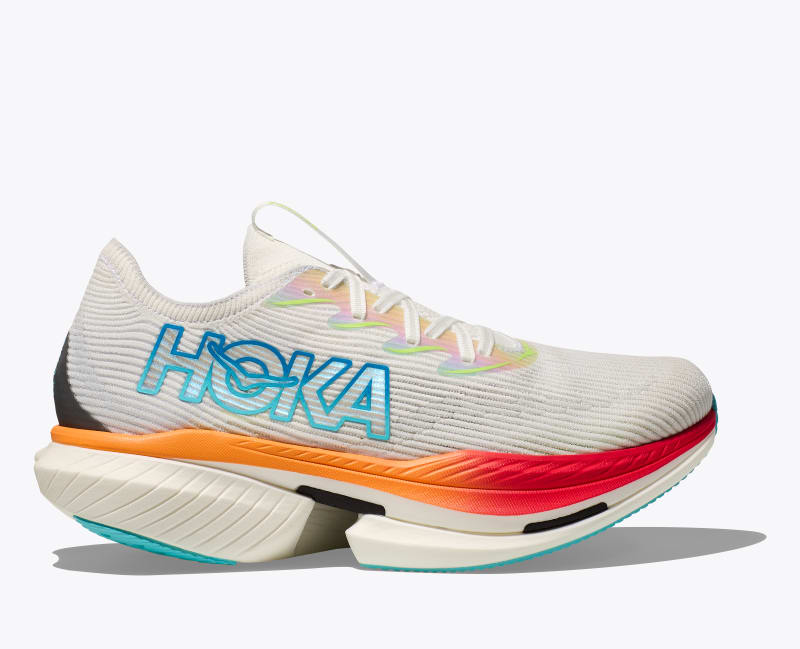
Hoka Cielo X1
One of the running shoes Hislop recommends (she wears these as a race shoe) is the Hoka Cielo X1 which features an aggressive rocker shape, dynamic cutouts to save weight, and a winged carbon fiber plate nestled between two layers of foam. What this all means is that these shoes are built for running—and running fast if your legs and lungs comply. The gusseted tongue and sock liner provide a secure, comfy fit.
“Running shoes are made for forward motion,” says Hislop. With these Hokas on your feet, you’ll be imbued with forward motion in spades.
Specifications
- Widths: Medium
- Materials: Rubber, foam, knit collar and upper
- Weight: 9.03 ounces
- Closure: Laces with knit collar
- Cushioning level: Responsive
- Drop: 7 mm
- Sizes: 5 - 15
- Colors: Orange/yellow, blue/green
- Price on publish: $275
Pros:
- Dynamic cutouts
- Breathable
- Carbon fiber plate adds propulsion and stability
The bottom line:
Lightweight running shoe with rocker sole, gusseted tongue, and a bouncy midsole with high energy return to help you run your fastest.

Brooks Ghost Max
Inherently different from running shoes, walking shoes should not have a big heel drop, says Hislop. She suggests looking for one with a maximum 8 mm drop. The reason for this, she explained, is that we run on one foot at a time (most people will land with their foot under their body on the midfoot) whereas when walking, it's more of a heel to toe action.
The Brooks Ghost, a lightweight, neutral shoe that provides great support through the arch and the midfoot, is a great choice and one that Dr. Oldani recommends. The plush cushioning absorbs pebbles, rocks, roots, and all the city pavement you can travel over no matter how far or how long you walk (great for both sight-seeing on cobblestone streets and trekking through forests.)
Specifications
- Widths: Medium, wide, extra wide
- Materials: Recycled materials including plastic bottles, rubber
- Weight: 9 ounces
- Closure: Laces
- Cushioning level: Plush
- Drop: 6 mm
- Sizes: 6 - 12
- Colors: Nine including white, red, papaya, and black
- Price on publish: $150
Pros:
- Made from recycled materials
- Plush cushioning
- Available in nine colors
The bottom line:
Neutral shoe with plush cushioning for excellent shock absorption—ideal for walking.
Best HIIT workout shoes for women: Nike Metcon 9

Nike Metcon 9
Featuring a wide, flat heel for balance and a durable mesh upper with a cool plastic, loosely woven overlay for stability, the Nike Metcon 9 is a popular shoe for HIIT and other cross training workouts. Hislop recommends this shoe, as does Calvin J Martin, Head Coach at Güdsport.
“You need a shoe that can support plyo box jumps, lateral hops, and weightlifting moves,” says Hislop. The Metcom checks all these boxes and more (like the lace lock system that prevents you tripping mid-workout). And they come in 13 different color combinations.
“Incredibly light and providing proper stability and support; it's perfect for workouts challenging power, strength, and cardiovascular fitness,” says Martin.
Specifications
- Widths: Medium
- Materials: Rubber, foam, breathable mesh
- Weight: 11 ounces
- Closure: Laces
- Cushioning level: Balanced
- Drop: 4 mm
- Sizes: 5 - 15
- Colors: 13 including rose pink, black, yellow
- Price on publish: $150
Pros:
- Wide heel for great balance
- Excellent traction
- Comes in a range of vibrant color combinations
Cons:
- Some reviewers report it runs small
The bottom line:
Nike shoe with low heel drop, great traction, foam cushioning, and a wide heel for balance; perfect for HIIT workouts.
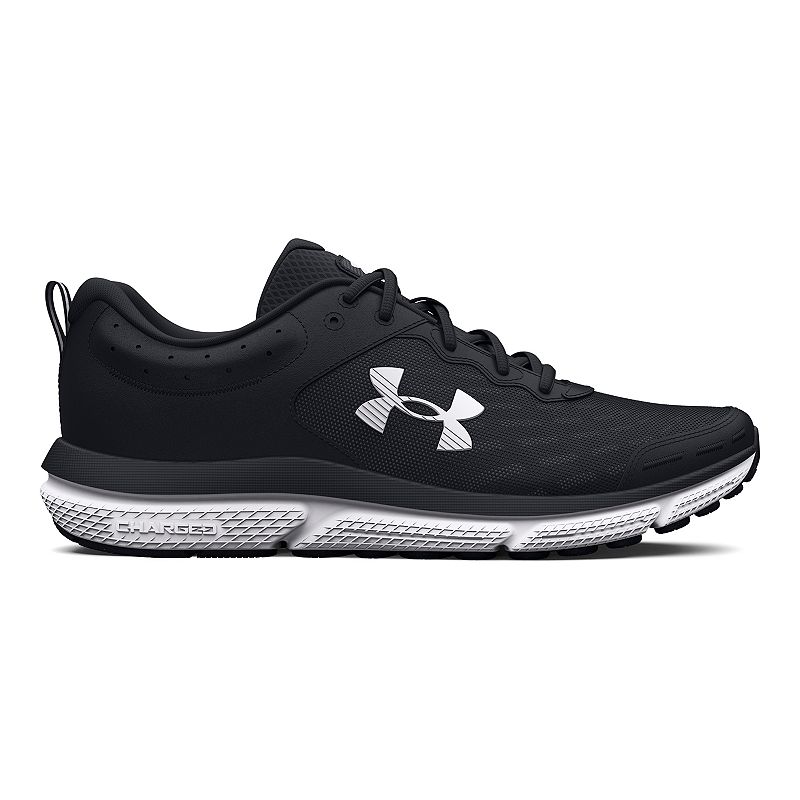
Under Armour Charged Assert
13% offSave $10
Billed as running shoes, the Under Armour Charged Assert features a compression molded foam midsole for responsiveness and cushioning, a breathable mesh upper, and rubber outsole with round lugs for traction.
While not plush, they provide a medium cushioning, perfect for people who don’t like the intense, thick foam found in Hokas and similar shoes. Their understated look means you can pair them with outfits outside the gym without looking as if you’re wearing your gym sneakers.
Specifications
- Widths: Medium, wide
- Materials: Mesh, leather, ethylene, vinyl acetate
- Weight: 8.9 ounces
- Closure: Laces
- Cushioning Level: Medium plush
- Drop: 10 mm
- Sizes: 5 - 12
- Colors: 23 including black, white, red
- Price on publish: $65 - $75 (depending on color)
Pros:
- Comfortable
- Great price
- Available in 23 colors
Cons:
- Some reviewers report they run small
The bottom line:
Understated basic gym show with medium plush cushioning and support, available in 23 colors at a budget friendly price.

New Balance Fresh Foam X 1080v13
The New Balance Fresh Foam X 1080v13 is one of the shoes Hislop recommends for a daily run. It’s one of New Balance’s most popular models and, according to the company, the shoe they’d make if they only manufactured one running shoe. Once you’ve tried out a pair of these, it's easy to see why. The foam midsole and rocker profile make your strides feel smooth as your foot transitions from ground to air, and mesh upper molds around your foot in a second skin type feeling. These are shoes that feel as if they are simply a part of you the longer and more often you wear them. They also come in four different widths.
Specifications
- Widths: Narrow, standard, wide, extra wide
- Materials: Rubber, foam, breathable mesh
- Weight: 7.3 ounces
- Closure: laces
- Cushioning level: Plush
- Drop: 6 mm
- Sizes: 5 - 13
- Colors: 14 including sea salt, orange, black, blue
- Price on publish: $164.99
Pros:
- Available in four widths: narrow, standard, wide, extra-wide
- Bouncy and quick
- Comfortable and stable
Cons:
- Some reviewers say they don’t have a lot of arch support
The bottom line:
Plush, supportive, lightweight running shoes from New Balance available in four widths so you can achieve a second skin like fit.
Best workout shoes for cross-training: Nobull Outwork

Nobull Outwork
Cross training shoes should be designed for movement—forward, backward, and lateral—says Hislop.
Martin recommends the NoBull Outwork Trainer because it “prioritizes comfort without compromising on style.” Rulon also suggests the Nobull as a great option for cross-training. (That’s three for three.)
The Outwork features a snug fit, ample cushioning, and breathable materials which makes for a comfortable shoe during training sessions no matter how long they may be. The rubber outsole provides extra grip when rope climbing, and the circular tread maintains traction in all directions. They’re also water repellent with reflective details for outdoor workouts. Plus Martin says it's sleek design and variety of color options allow for personal expression. Just because you’re at the gym, doesn’t mean you can’t let your individual flair shine.
Specifications
- Widths: Medium
- Materials: Rubber, suede, foam, “SuperFabric”
- Weight: 11 ounces
- Closure: Laces
- Cushioning level: Medium
- Drop: 4 mm
- Sizes: 5 - 11
- Colors: Black, black/green, gray, denim, beige
- Price on publish: $125
Pros:
- Sleek design
- Grippy rubber sole
- Stable and uncomplicated
Cons:
- Some reviewers report they run small
The bottom line:
Uncomplicated training shoe with a low drop, grippy sole, and excellent traction for cross-training workouts.
Best for gym to outdoors shoes for women: Converse All Stars

Converse All Stars
Surprising, but true: Converse All Stars are a great choice if your workout routine is strictly focused on weight lifting. And, if you’re going straight from the gym to the outdoors or vice versa and don’t want to change your shoes, nothing beats a pair of good old fashioned Chuck Taylor’s (again, as long as you’re just lifting weights). Rulon has used them for years. The iconic Converse All Star features a flat sole, high top lace up sneaker style, and the telltale All Star license plate and ankle patch.
Specifications
- Widths: Medium
- Materials: Rubber, foam, canvas
- Weight: 10 ounces
- Closure: Laces
- Cushioning level: Minimal
- Drop: 0
- Sizes: 5 - 18
- Colors: 20 including white, black, red
- Price on publish: $65
Pros:
- Stylish
- Zero-drop for weight lifting
- Versatile
Cons:
- Not recommended for running
The bottom line:
Iconic high top, zero drop lace up sneaker from Converse best suited for weight lifting.
TIEM Slipstream Indoor Cycling Shoes
While cycling shoes in general, are not comfortable to walk around in when off the bike, the TIEM Slipstreams come with enough cushioning in the sole to thwart that assumption. Plus, they look and feel like a regular gym sneaker as opposed to an obvious cycling shoe.
Manufactured with a recessed cleat attachment area in the middle front of the rubber outsole, the bottom of the shoe remains level even with SPD cleats installed. (SPD cleats feature a 2-bolt system, not a 3-bolt one.) Like cycling shoes for outdoor bikes, the cleats are not included.
Specifications
- Widths: Medium
- Materials: Rubber, foam, mesh, cotton jersey
- Weight: 1 pound, 6.2 ounces
- Closure: Slip-on, single strap
- Cushioning level: N/A
- Drop: N/A; SPD cleat compatible
- Sizes: 5 - 12
- Colors: Seven including gray, black, camo
- Price on publish: $135
Pros:
- Recessed SPD cleat compatible
- Comfortable even when walking
- Rubber sole with traction
The bottom line:
SPD cleat cycling shoes that look and feel like a regular sneaker.
Best workout shoes for treadmill: Hoka Clifton 9

Hoka Clifton 9
Another running shoe Hislop recommends, the Clifton 9 stands out as one of Hoka’s lightest and most cushioned running shoes. It features a responsive compression molded foam insole with a plusher heel and more stack height than earlier iterations, a less bulky gusseted tongue and a rubber outsole engineered for extended resistance to abrasion (meaning it won’t wear out as fast as others). And, it's certified by the American Podiatric Medical Association.
Specifications
- Widths: Regular, wide
- Materials: Rubber, foam, polyester knit, recycled materials
- Weight: 8.7 ounces
- Closure: Laces
- Cushioning level: Balanced (medium)
- Drop: 5 mm
- Sizes: 5 - 16
- Colors: 11 including yellow, black, blue, and green
- Price on publish: $145
Pros:
- Comes in 11 color combinations
- Lightweight
- Abrasion resistant sole
Cons:
- Some reviewers report they feel a bit stiff out of the box
The bottom line:
Lightweight everyday running shoe from Hoka featuring balanced, medium cushioning, neutral stability and a meta-rocker sole.
Best splurge workout shoes for women: APL Streamline
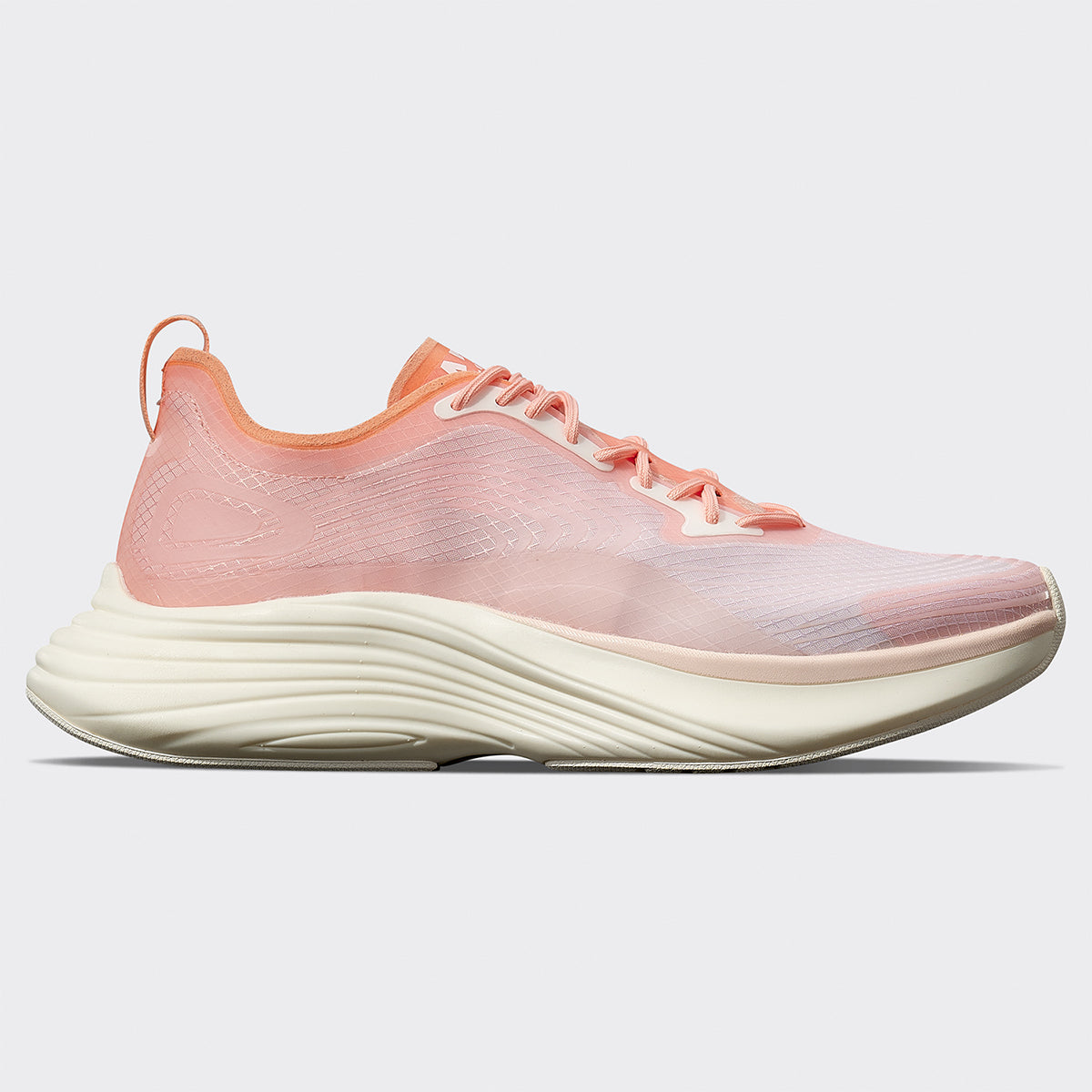
APL Streamline
Athletic Propulsion Lab’s Streamline running shoes feature a midsole and outsole made from what the company calls FutureFoam—a compound meant to provide the best in comfort and cushioning, as well as speed. In between the two-piece midsole, there’s a “slanted forward leaning shank plate” that encourages forward motion when your foot strikes; kind of like a tiny little ramp or springboard. At 7.3 ounces the Streamline is incredibly lightweight, and they look super cool, too. I especially like the multi-colored striped patterns.
Specifications
- Widths: Medium
- Materials: Rubber, foam, souffle, woven upper
- Weight: 7.3 ounces
- Closure: Laces
- Cushioning level: Plush
- Drop: 8 mm
- Sizes: 5 - 11
- Colors: 50 including cream and rose ombre, black, and multicolored striped
- Price on publish: $320
Pros:
- Available in 50 colors
- Lightweight
- Comfortable and cushioned foam
Cons:
- Expensive, especially since I’m inclined to buy more than one pair
The bottom line:
High-tech, plush running shoe made with a new foam compound that creates a springy feel and minimal air resistance.
How to maintain and clean workout shoes for women
Workout shoes are an investment, says Hislop. They will last longer if you make sure they dry out properly after use. Wadded up newspapers stuffed into shoes are a great and quick way to dry them out (as is putting them in a sunny spot).
If they are really dirty or covered with salt from a winter snow run, bathe them in the sink with a mild detergent. Pull out the insole and wash. For smelly shoes, she suggests a vinegar and water rinse.
How to select the right size for a comfortable fit
Hislop says that for “far too long women (and many men) have crammed their feet into shoes that are too small.” Black toenails are a result of the toe hitting the front of the shoe while running. This can be avoided with the right size shoe.
“A good rule is to make sure there is a thumb width between your longest toe and the front of the shoe,” she said. Also, most people have one bigger foot. Measure that foot! “There are many different lacing options to create a good fit on the 'too big' shoe.”
How we test and select the best workout shoes for women
I’ve been a runner since I was 12 years old and discovered that lacing up a pair of shoes and running circles around the high school football field was an excellent way of escaping and clearing my head. About forty years later, I still run (albeit not as fast or as often), as well as cycle, lift weights, and do pilates. Many of the shoes on this list I’ve tried out myself. I have excessive overpronation and a torn meniscus, so I’ve experimented with many pairs of running shoes in my life. I also talked to experienced coaches and personal trainers, as well as a couple podiatrists to compile this list of the best workout shoes for women.
What to consider when buying workout shoes for women
Activity
Timothy Oldani, DPM, FACFAS, board certified podiatrist at Missouri Foot & Ankle, says that the most important thing to consider when choosing a workout shoe, is matching the shoe to your activity and foot type. “For example,” he said, “if someone has a flexible flat foot and struggles with pronation, look for a shoe with maximum support through the arch and a motion control component.”
People with high arches who struggle with shock absorption through the heel and ball of the foot should look for a shoe with maximum cushioning in those areas. If you’re beginning a workout regimen, consider consulting a podiatrist for an initial evaluation, as they can help pick a shoe that will be the best choice. Especially, if you’re in need of shoes for plantar fasciitis or shoes for flat feet.
For hikers and outdoor runners, the quality of the shoe grip is another important feature to assess. “Shoes that slip and slide on looser terrain may predispose to one losing their balance,” said Rahul Shah, MD, FAAOS, a board certified orthopedic surgeon at Premier Orthopedic Associates.
With activities such as long-distance running, you should also keep in mind that feet can increase in size as they swell when running for longer periods, he added. “In this case,” he said, “a wider toe box can be helpful provided the shoe has enough arch support and heel support.”
However, don’t go too wide. If a shoe has too much room, especially when participating in exercises that have high amounts of cutting (such as basketball), your foot can slip around inside when you abruptly change direction. This forces the knee and ankle to bear more of the brunt of the torque subjecting them to a greater likelihood for injury, he explained.
Dr. Shah doesn’t recommend any specific brands, mainly because everyone’s individual foot anatomy and body influences how they walk, step, and land. Just like snowflakes, each of us possess a unique running gait.
Cushioning
Workout shoes or even just comfortable shoes for standing all day are available with different levels of cushioning. Various companies refer to this in different ways. Hoka, for instance, calls their highest level of cushioning “plush” while others may refer to it as maximal. No matter what term they use, there are generally three levels available: minimal, medium, and maximum.
“People wearing maximal shoes will often say they are running on clouds,” said Hislop. “You won’t be able to tell the difference in the foam used by just looking at them,” she continued. You really need to try them on to see how they feel.
“Maximal shoes are nice on the joints and people like them for longer runs because they often find recovery is a bit better using them,” explained Hislop. However, you won’t feel the road when you run in a maximal shoe and your foot muscles won’t respond to the ground.
In general, the cushioning in a running shoe will be too high for weight lifting,” said Rulon. For lifting, the shoe should have minimal cushion and a low drop.
If a shoe has a cushioned sole, it doesn’t necessarily mean it can’t also have a low drop. Hokas, for instance, are known for their high, plush soles, but most have drops of about 4 or 5 mm.
Speaking of drops…
Drop
Drop measures the distance in height between the heel and toe of a shoe, normally calculated in millimeters. A zero drop means there is no difference in height from the heel to toe.
“It’s like walking barefoot, but with protection,” says Hislop. While you can buy zero drop shoes for running, walking, hiking, and lifting, they’re best for people who have spent time and attention to foot strength. “It’s tough to go from a highly cushioned stabilizing shoe to a zero drop,” explained Hislop.
A popular example of a zero drop shoe are Vibram’s five finger “barefoot” shoes.
Support
Running shoes are typically categorized as stability, motion control, or neutral, Hislop told me.
Shoes with stability help with overpronation. “We all pronate when we run, but some people have excessive pronation and a stability shoe will help—so will strengthening exercises and doing strength work in a lifting shoe!” she said. Most shoes in this category have a fairly high arch.
Motion control shoes also help with overpronation but do not have a high (supported) arch. Instead, they offer more support in the heel cup.
A neutral shoe possesses no extra features for pronation or arch support. They tend to be a bit lighter than stability/motion control. Hislop says most runners can wear a neutral shoe.
Frequently asked questions (FAQs)
Are there specific features that make workout shoes ideal for women?
There aren’t any women-specific features that make a particular shoe better than another, only the shoe that works best for your individual foot.
Can I use running shoes for other types of workouts?
“Yes, one hundred percent, people do it all the time,” said Rulon.
When she works with clients in the gym, she asks them to go barefoot or with socks to stay connected with the floor when doing squats or a deadlift. If that doesn’t work, she’ll ensure they have a lower-sole running shoe versus one with a thick-sole shoe.
“I’ve seen good old-fashioned Converse Chucks in many gyms and have personally used them for years,” she said.
How do I know if my workout shoes fit correctly?
“If you head into a “global store” to get shoes, ensure you have a thumbnail’s width between your longest toe and the end of your shoe when you stand up. The goal is to ensure no pinching or rubbing on your toes,” said Rulon. Many stores also have staff that will look at your gait and form while you run on a treadmill to help you obtain an optimal fit.
Above all, your shoes should feel comfortable. Some running stores offer a 30-day guarantee, which means you can actually go out and run in them and still return and exchange them if they don’t work for you.
“A fantastic online store to help you with shoes you may need is Road Runner Sports,” said Rulon.
When shopping for new shoes, Daughtry recommends the following to make sure they fit correctly:
- Shop for your shoes closer to the end of the day to allow for any potential swelling.
- Wear the socks that you plan to wear in the shoes as well as any arch supports you need.
- Trace your foot and take it with you (if you don’t have orthotics or arch supports that fit well), so you can place it on the shoe to make sure it isn’t too narrow or too short for your foot shape.
- Stand up in the shoes and walk around the store to make sure they fit properly. There should be about a half-inch or thumb’s width of space between the longest toe (not necessarily the great toe) and the end of the shoe.
- Measure both feet and get measured every time you buy new shoes. Feet widen and flatten over time, so your shoe size can change. Similar to clothes, different brands fit differently, so a different shoe size may be needed in some brand names.
- Be aware of your foot shape and the style of the shoe. Someone with a wider forefoot does not want to pick a shoe with a more pointed toe box as this may cause crowding of the toes.
- Feel the inside of the shoe to make sure no tags, seams, or other material may irritate or rub your foot, particularly bony prominences.
How often should I replace my workout shoes?
Ideally, Rulon suggests replacing your workout shoes every 6 to 9 months. If you go to the gym at least five times a week, you may need to replace them every 3 to 4 months. She likes to rotate her shoes so no one pair gets worn down right away.
“I write the date on the inside when I start using them,” she said. She also logs all her workouts which means she knows when her shoes need to be replaced.
“Now, I live in Costa Rica where some of the gyms require you to take your shoes off, so for my strength training, I use good old-fashioned feet now, and I love them!” she told me.
Many running shoe manufacturers say you can get 400 miles from a pair of shoes. If you’re not someone who tracks actual miles logged with each shoe you own, the other ways to tell are if your feet begin to feel sloppy and unsupported, the tread is worn on the bottom, or the shoe has lost its springy cushioning, Hislop said.
Run shoes will wear out fastest. Walking shoes will last longer (500 to 600 miles). Lifting and specialty shoes can last longer if you only use them inside for a specific activity.
“If your shoe is peeling apart (uppers or lowers) it is time to replace it,” said Hislop. “If your toe has pushed through the end then it is time to size up and replace. If you have had an injury it might be time to replace it with a new style or brand.”
Your shoes will also last longer if you use them for the correct purpose. Some ways to make your shoes last longer according to Hislop are giving your run shoes 48 hours for the foam to rebound, keeping your shoes clean, and letting them dry out after use.
Can I wash my workout shoes in a washing machine?
The washing machine and dryer will absolutely decrease the life of your shoes, says Hislop.
